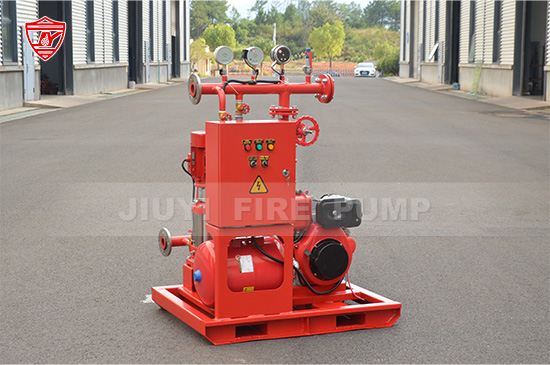Fire pumps are the core of any reliable fire protection system. They ensure stable and adequate pressure when demand suddenly increases during a fire emergency. However, like all mechanical equipment, fire pumps can fail if not monitored, tested, and maintained properly. Early detection of issues is crucial not only for system reliability but also for compliance with international standards such as NFPA 20.
This article explains the most common early warning signs of fire pump failure, why they occur, and how technicians, building owners, and maintenance teams can catch problems before they escalate. Understanding these signals is essential for anyone responsible for fire safety performance, especially in commercial, industrial, and high-risk facilities.

A well-functioning fire pump runs with consistent, stable sound. Any sudden change in noise can indicate a mechanical or hydraulic problem.
Grinding or rattling: caused by worn bearings, misalignment, or internal component wear.
High-pitched squealing: may indicate belt tension issues in electric pumps or failing bearings.
Cavitation noise (rumbling like gravel): caused by insufficient water supply or excessive suction lift.
Noise changes typically occur before major mechanical breakdowns. Cavitation, for instance, can severely damage the impeller if left unresolved.
Investigate immediately. Check suction conditions, alignment, coupling condition, and ensure the water supply is adequate and unobstructed.
A fire pump must deliver its rated pressure and flow. Any measurable drop indicates a performance issue.
Pressure does not reach the expected level during a weekly test.
Pressure fluctuates during operation, especially under demand.
Pressure relief valve activates more frequently.
Impeller wear or blockage
Air leaks in suction piping
Obstructed strainers
Relief valve malfunction
Seal or gasket deterioration
Pressure deviation is one of the earliest signs of pump degradation. A pressure loss during an emergency could be catastrophic for life safety and property protection.
Fire pumps generate natural vibration, but excessive or new vibrations indicate misalignment or mechanical damage.
Pump base shaking
Coupling moving irregularly
Increasing vibration levels over weekly or monthly tests
Worn bearings
Loose mounting bolts
Shaft misalignment
Unbalanced impeller
Damaged coupling
Unchecked vibration accelerates wear, reduces lifespan, and can lead to sudden failure.
Leakage is a visible and early symptom of mechanical problems.
Water dripping from mechanical seals
Flange gasket leaks
Diesel pump fuel or oil leakage
Packing gland overheating
Small leaks lead to pressure instability, corrosion, pump overheating, and possible system shutdown.
Repair seal leaks immediately. Regular gasket and packing checks are essential for preventing further damage.
Temperature abnormalities usually occur around the motor, bearings, casing, or diesel engine components.
Motor running hotter than normal
Bearings too hot to touch
Diesel engine coolant temperature rising
Pump casing unusually warm
Motor overload
Bearing lubrication failure
Friction from misalignment
Inadequate ventilation
Blocked cooling system
Heat is one of the most reliable indicators of internal stress in any rotating machine.
Fire pumps—whether electric or diesel—must start instantly when commanded.
Electric pump hesitates before reaching full speed
Diesel engine cranks multiple times before ignition
Control panel alarms for start sequence delays
Weak battery (diesel)
Faulty wiring or loose connections
Damaged starter motor
Controller relay malfunction
Incorrect fuel-air mixture in diesel pumps
Starting failure is one of the most critical risks because it prevents the pump from operating during a life-safety emergency.
Fire pump controllers are designed to detect abnormalities. Frequent alarms should never be ignored.
Phase failure
Low voltage
Battery charger failure
Diesel low fuel
Overload conditions
Pressure switch malfunction
A pump might still run after an alarm, but repeated faults usually indicate deteriorating components or improper system environment.
Flow rate changes can occur even when pressure seems normal.
Lower-than-normal flow during annual testing
Flow drops at certain demand points
Pulsating flow patterns
Suction blockage
Air entrainment
Impeller erosion
Valve malfunction
System leaks downstream
Flow reduction often results from hydraulic problems that worsen over time if not addressed.
Diesel fire pumps involve additional mechanical systems that must remain in perfect condition.
Unstable RPM
Excessive exhaust smoke
Abnormal engine vibration
Low oil pressure
High fuel consumption
Battery not maintaining charge
These issues can compromise starting reliability and performance during emergencies.
Electric-driven fire pumps rely on a stable power supply and healthy electrical components.
Motor running louder than usual
Overheating control panel components
Tripped breakers
Irregular current draw
Voltage imbalance
Electrical imbalances can burn out motors or damage controllers if not addressed promptly.
A fire pump must have a stable and unobstructed water supply to work properly.
Cavitation noise
Visible air bubbles at discharge test points
Inconsistent pressure
Frequent priming issues in vertical turbine pumps
Low water level in the source
Suction piping leaks
Strainer clogging
Foot valve malfunction
Addressing suction issues early prevents severe hydraulic damage to the pump.
Regular testing is one of the most reliable ways to detect early pump deterioration.
Gradual decline in pressure over months
Increasing vibration levels
Longer start-up times
Diesel fuel consumption rising
Flow readings decreasing each year
Fire pump failures rarely happen suddenly. Most problems develop slowly and can be detected early through consistent testing.
Any burnt smell or smoke is a critical early warning sign.
Motor overload
Electrical short
Bearing failure
Overheated diesel engine
Insulation failure
These require immediate shutdown and professional inspection.
Corrosion is often overlooked but one of the most destructive long-term threats.
Rust on flange bolts
Corrosion on pump casing
Paint peeling due to moisture
Pitted surfaces near the suction or discharge sides
Corrosion weakens structural integrity, affecting pump performance and lifespan.

Fire pump failure does not happen overnight. Almost every major failure begins with early signs: unusual noise, leaks, vibration, pressure fluctuation, slow start, or controller alarms. By recognizing these indicators early, maintenance teams can take action before minor issues become life-threatening failures.